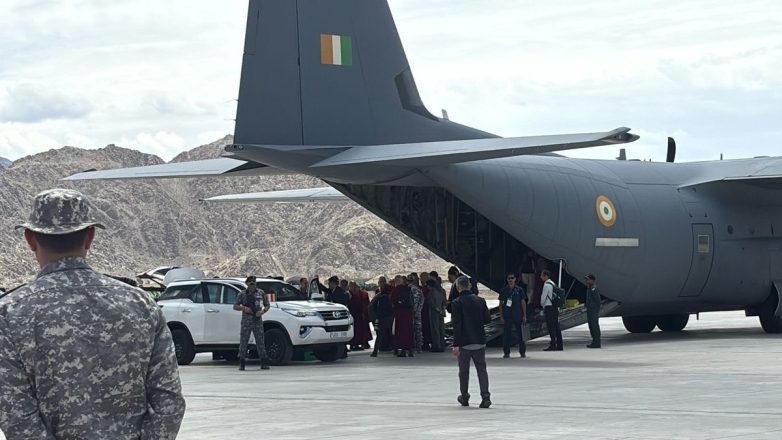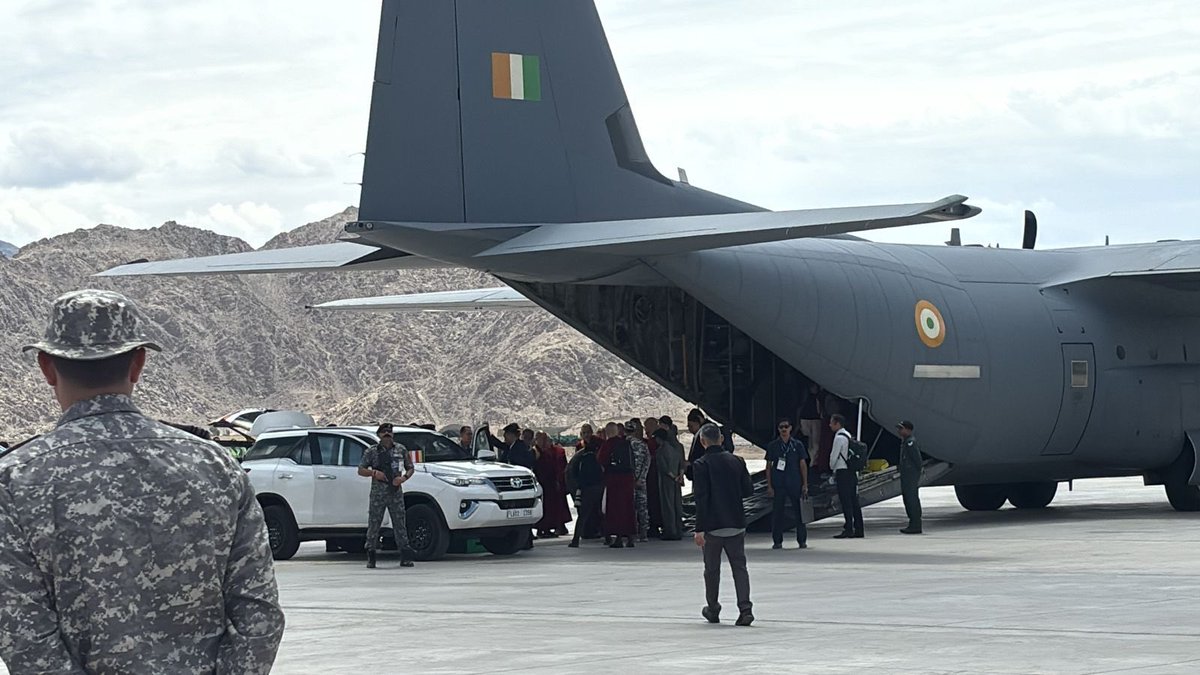
Dalai Lama’s Arrival in Ladakh Sparks Outrage: Will China Retaliate?
Tibetan leader visit, IAF transport aircraft, geopolitical tensions in Asia
Dalai Lama Arrives in Ladakh: A Significant Moment for India and Tibetan Buddhism
In a remarkable event that has captured international attention, the Tibetan spiritual leader, the Dalai Lama, has landed in Ladakh, India, aboard an Indian Air Force (IAF) C-130J transport aircraft. This significant arrival is not only a momentous occasion for the Tibetan community and its supporters but also an event that is likely to stir reactions globally, particularly from China.
The Context of the Dalai Lama’s Visit
The Dalai Lama, who has been a symbol of peace and non-violence, fled to India in 1959 following the Chinese takeover of Tibet. Since then, he has established a strong presence among Tibetan exiles, advocating for their rights and promoting the values of compassion and understanding. Ladakh, a region with a significant Buddhist population, is a crucial area for the Tibetan Buddhist community. The arrival of the Dalai Lama in this region is anticipated to enhance cultural ties and provide spiritual encouragement to many.
India’s Strategic Role
India has long been viewed as a refuge for the Dalai Lama and the Tibetan populace, providing a space for cultural preservation and religious freedom. The use of an IAF C-130J transport aircraft for his arrival signals not only logistical support but also India’s commitment to Tibetan rights. This military transport is a stark reminder of the strategic importance that India places on its relationship with Tibet, especially against the backdrop of Sino-Indian tensions.
Reactions from China
This visit is likely to provoke a strong reaction from the Chinese government. China regards the Dalai Lama as a separatist and often condemns any actions that appear to support Tibetan autonomy or independence. The tweet accompanying the announcement of the Dalai Lama’s arrival hints at an anticipated “meltdown” from China, suggesting that the diplomatic ramifications of this visit could escalate.
China’s response has historically included diplomatic protests and attempts to undermine the Dalai Lama’s influence. The Chinese government has also been known to intensify its rhetoric against both India and the Dalai Lama, framing him as a threat to national unity.
The Significance of Ladakh
Ladakh holds a special place in the hearts of many Tibetans and Buddhists alike. The region is known for its stunning landscapes, rich culture, and a history intertwined with Tibetan Buddhism. The Dalai Lama’s visit to Ladakh is expected to bolster the morale of the Tibetan community and reinforce their cultural identity.
Additionally, Ladakh has been the focus of increased geopolitical interest, especially with the ongoing territorial disputes between India and China. The Dalai Lama’s presence in this strategically important region serves as a reminder of India’s commitment to safeguarding cultural heritage and promoting peace.
Potential Impacts on Tibetan Buddhism
For Tibetan Buddhists, the Dalai Lama is not only a religious leader but also a symbol of hope and resilience. His teachings advocate for compassion, mindfulness, and the importance of community, making his presence in Ladakh particularly poignant. This visit is expected to inspire many, encouraging them to uphold their spiritual practices and cultural traditions, especially amid challenges posed by external pressures.
The Dalai Lama’s teachings have gained global recognition, and his arrival in Ladakh could potentially attract visitors and pilgrims from around the world. This influx could provide a boost to the local economy while promoting intercultural dialogue and understanding.
Conclusion: A Moment of Hope and Tension
The arrival of the Dalai Lama in Ladakh marks a significant event not just for Tibetans, but for the broader context of Indo-Tibetan relations and the geopolitical landscape in Asia. As tensions between India and China continue to simmer, the Dalai Lama’s visit serves as a reminder of the ongoing struggle for cultural preservation and the quest for peace.
This moment encapsulates the delicate balance between spiritual leadership and political realities, highlighting the importance of dialogue and compassion in resolving conflicts. As the world watches closely, the implications of this visit will undoubtedly reverberate beyond the borders of Ladakh, impacting international relations and the future of Tibetan Buddhism.
With the Dalai Lama’s presence, there is hope for renewed dialogue and understanding, not just among the Tibetan community but also between nations. As history unfolds, one can only hope that this visit will pave the way for greater compassion and cooperation in the region.

BREAKING NEWS
Tibetan Leader Dalai Lama lands in Ladakh via IAF C-130J transport aircraft
— China’s meltdown will be next level pic.twitter.com/XTNTyjx6UQ
— Megh Updates (@MeghUpdates) July 12, 2025
Breaking News: Dalai Lama Lands in Ladakh
Hey there! Have you heard the latest buzz? The Tibetan leader, the Dalai Lama, has just touched down in Ladakh aboard an IAF C-130J transport aircraft. This is not just any routine visit; it’s a significant moment that’s likely to stir some discussions, particularly concerning China’s reaction. So, let’s dive into what this means for India, Tibet, and the larger geopolitical landscape.
The Significance of the Dalai Lama’s Visit
For many, the Dalai Lama is not just a spiritual leader but a symbol of hope and resilience for Tibetans and many others around the world. His arrival in Ladakh, a region that shares cultural and historical ties with Tibet, is seen as a bold statement. Ladakh has become a focal point of India’s strategic interests, especially given its proximity to the Tibetan plateau and China.
Why Ladakh?
Ladakh, nestled between the mighty Himalayas and the Karakoram range, has been in the spotlight for several reasons, particularly in recent years. With its unique demographics and cultural heritage, it has become a melting pot of Tibetan Buddhism and Indian culture. The visit of the Dalai Lama further solidifies this connection. It’s a reminder of the shared history and aspirations of the Tibetan people, many of whom look to him for guidance and inspiration.
The IAF C-130J Transport Aircraft
Now, let’s talk a bit about the aircraft that brought the Dalai Lama to Ladakh. The IAF C-130J is no ordinary plane. It’s a state-of-the-art transport aircraft used by the Indian Air Force for various operations, including humanitarian missions and troop transport. Its use in this context highlights the seriousness of the visit and the importance that India places on it.
Military and Humanitarian Implications
Using a military transport aircraft for a spiritual leader’s visit might raise eyebrows. However, it underscores the logistical challenges of reaching remote areas like Ladakh, especially during inclement weather. More importantly, it signals India’s commitment to safeguarding its borders and maintaining a strong presence in the region. This military aspect cannot be overlooked, especially considering the ongoing tensions between India and China.
China’s Potential Reaction
Now, speaking of China, the tweet accompanying this news hints at a potential “meltdown” from their side. Historically, China has reacted strongly to any recognition of the Dalai Lama, viewing him as a separatist figure. His presence in Ladakh could escalate tensions between the two nations, especially as both countries have competing territorial claims in the region.
Geopolitical Ramifications
With the Dalai Lama in Ladakh, we might witness a ripple effect throughout the region. China might ramp up its rhetoric against India, framing the visit as a provocative act. This could lead to increased military posturing on both sides, creating a tense atmosphere in the already volatile border regions. The international community will likely be watching closely, as this visit could reshape diplomatic dynamics in South Asia.
The Importance of Dialogue
While the situation may seem tense, it’s crucial to remember the importance of dialogue. The Dalai Lama has always advocated for peaceful resolutions and mutual understanding. His presence in Ladakh could serve as a catalyst for discussions about the future of Tibet, its autonomy, and the broader relationship between India and China.
Encouraging Peaceful Solutions
In light of this, it’s essential for both India and China to approach the situation with diplomacy rather than aggression. The Dalai Lama’s teachings emphasize compassion and understanding, which could be instrumental in easing tensions. Could this visit be an opportunity for both nations to reaffirm their commitment to peace?
The Cultural Impact of the Dalai Lama’s Visit
Beyond the political implications, the Dalai Lama’s arrival in Ladakh also has significant cultural ramifications. His teachings and presence inspire many, especially in areas with strong Tibetan cultural influences. It’s a chance for local communities to engage with their heritage and reflect on their identity.
Revitalizing Tibetan Culture
For Tibetan Buddhists, the Dalai Lama is a spiritual beacon. His teachings on compassion, mindfulness, and non-violence resonate deeply within the community. His visit could lead to a revitalization of interest in Tibetan culture, traditions, and practices among the youth, who may feel disconnected from their roots in the modern world.
What’s Next for the Dalai Lama?
So, what’s next for the Dalai Lama after this historic landing? While his schedule has not been fully disclosed, we can expect a series of public engagements, teachings, and interactions with the people of Ladakh. His ability to connect with individuals from all walks of life is remarkable, and many will be eager to hear his insights on various issues.
Future Visits and Engagements
It’s likely that this visit will pave the way for more interactions between the Dalai Lama and the people of Ladakh. It’s an opportunity for him to share his wisdom, promote Tibetan culture, and foster a sense of community. His presence could also encourage dialogue among different groups, promoting unity and understanding.
Global Attention on Tibet
The Dalai Lama’s visit to Ladakh is not just a local event; it has the potential to draw international attention to the situation in Tibet. With various human rights organizations and countries keeping a close watch, this visit could reignite discussions about the rights and freedoms of Tibetan people.
Raising Awareness on Tibetan Issues
In recent years, there has been a growing global movement advocating for the rights of Tibetans. The Dalai Lama’s presence in Ladakh could serve as a platform to raise awareness about the challenges faced by the Tibetan people, including issues related to cultural preservation, human rights, and autonomy.
The Role of Social Media
With the rise of social media, news travels faster than ever. The tweet from @MeghUpdates encapsulates the excitement and concern surrounding the Dalai Lama’s visit. Social media will play a crucial role in shaping public perception and discourse around this event.
Engaging the Global Community
People from all over the world can engage with the situation through platforms like Twitter, Facebook, and Instagram. This engagement can lead to a more informed global audience, rallying support for Tibetan causes and encouraging dialogue around the issues that matter most to the Tibetan people.
Conclusion: A Moment of Reflection
As we reflect on the significance of the Dalai Lama’s landing in Ladakh, it’s clear that this is more than just a visit; it’s a moment of potential change. The implications stretch from the local cultural scene to international diplomacy. For Tibetans, it’s a reminder of their rich heritage and the ongoing struggle for recognition and rights.
Whether you’re a supporter of the Dalai Lama, a follower of Tibetan Buddhism, or simply curious about global affairs, this event offers a lot to think about. The road ahead may be challenging, but with compassion and dialogue, there’s always hope for a brighter future.
BREAKING NEWS Tibetan Leader Dalai Lama lands in Ladakh via IAF C-130J transport aircraft — China’s meltdown will be next level